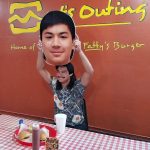
Editor’s Note: This story has been updated 1:16 p.m. Nov. 21 to reflect a correction. Rhett Rushing formerly worked for the Institute of Texan Cultures. He is not currently an employee there.
By Jesse Cazares
Bizarre and shocking stories of the unfortunate, tragedies, and of unresolved fates fill the oral tradition of San Antonio’s Southside. Parents and grandparents hand down the rich South Texas folklore to instill values in the younger generation, according to expert Rhett Rushing.
One of the most often repeated tales concerns the devil and the dance hall or the pata de gallo.
The story features a beautiful twelve-year-old year girl who defied her father’s orders to stay home and instead went out to the town dance hall.
There dozens of men invited her to dance. She declined every offer except one.
She responded only to a tall, handsome man with piercing, slick looks. They danced the night away. As the music intensified, her partner’s controlling grip made the girl feel increasingly uncomfortable.
Suddenly, a scream in the crowd shocked everyone there. The gorgeous man had a grotesque chicken leg. Horrors! The crowd broke away in panic. Dancers scattered. The girl froze in terror and fainted.
Once she awakened, she discovered three long, deep claw marks across her face from chin to ear, scarring her once beautiful porcelain skin.
Adults tell stories like this one to create fear and trembling among the young.
Rushing said we create tales of the extreme consequences of actions like disobeying a parent to discourage such behavior.
Rushing, a master storyteller, studies folklore professionally. He previously served as folklorist at the Institute of Texas Cultures and holds a doctorate in the subject. He has traveled all over Texas investigating, listening, and documenting the stories. He also has taught folklore courses at Indiana University and Texas State University.
“Folklore as a whole deals with human fears,” Rushing said. “The classic stories tell us you’re not supposed to mess with stuff like that. Don’t mess with the chaos…Obviously something bad happens to people doing it.”
Folklore creates justice for society.
“We humans put order into chaos to make it understandable,” Rushing said.
If the tale makes a child cry, learn a lesson and avoid unwanted behavior, it serves its purpose.
“If you’re a little kid and you are afraid of the dark, that can be manipulated…If you’re a parent and you don’t want your nine-year-old running around after midnight, you tell them this horrendous story about lechuza and scare the snot out of them. They won’t set foot out of their bedroom,” Rushing said.
So why do stories of horror and fear continue in the culture?
Rushing said, “We get into the fear and we use the fear to actually teach a lesson about morality…”
In the big picture human beings order their world narratively, Rushing said.
The narrative structure of folklore helps make it even more natural, effective and appealing.
“We have a beginning middle and end to everything we do. Everything in our minds is ordered narratively. We think in a narrative structure,” Rushing said.
Folklore lessons stick home. “So much so that they are repeated over and over among peer groups and across generations,” Rushing said. “And even across cultures. Origins really don’t matter, other than context and setting the scene. The forms are as old as human beings. They’re as old as communication.”
Rushing says folklore works because it contains an element of truth.
“Whether it be settings, realia, or the nouns in the story. That’s what makes it believable or enjoyable, or meaningful enough to pass on,” he said.






